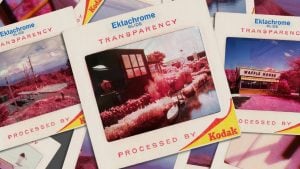

Kodak Aerochrome was a unique film loved by many photographers to this very day. Sadly, Kodak discontinued it in 2009, and while new rolls are no longer available, the legacy of Aerochrome lives on. Photographers still try to replicate the effect using digital manipulation or alternative film stocks – and Jason Kummerfeldt, aka Grainydays, took this route as well.
In his recent video, he guides you through his process of replicating Kodak Aerochrome look through the combination of digital and film photography paired with a converted camera, filters, and macro lenses.
An ode to Kodak Aerochrome
Kodak Aerochrome was a unique film revered for its false-color infrared capabilities. Unlike regular film, Aerochrome captured near-infrared light, rendering colors in an unnatural, dreamlike way. Vegetation appeared in vibrant shades of red and purple, while water often took on a turquoise or blue hue.
Originally developed in 1942, Aerochrome was initially used for camouflage detection during World War II. Its ability to differentiate between foliage and human-made objects proved valuable for military purposes. But after the war, photographers discovered the film’s artistic potential. The unique color palette and ability to capture details invisible to the naked eye made it a favorite among landscape and fine art photographers.
As I mentioned, Kodak discontinued Aerochrome in 2009, making the remaining rolls highly sought-after and expensive. Expired canisters can fetch hundreds of dollars, with individual frames costing over $10. But folks like Jason find their way of dealing with this, and his method is ingenious, although quite complex.
Recreating the Kodak Aerochrome look
To replicate Kodak Aerochrome, Jason followed a complex process involving a full spectrum digital camera, specific lenses, filters, and post-processing techniques. Here’s a quick breakdown:
Full spectrum digital camera conversion: Jason starts with a digital camera with UV and infrared light blockers removed or adjusted through full spectrum conversion.
Lens and filter selection: Next, Jason picked out the lenses that don’t suffer from infrared hot spotting and preferably have an infrared focus scale. He also used a yellow filter to block visible blue light and a UV filter to block UV light.
Shooting techniques: For this process to work, Jason recommends shooting in bright midday light, using the camera’s base ISO, setting the white balance low, and underexposing shots slightly to capture infrared effectively.
Post-processing: After taking photos, Jason processes them in Photoshop using a specific workflow. He first duplicated the image three times and split out the channels into red, green, and blue. He deducted infrared pixels from the red and green channels and recombined them using blending modes and adjustment layers. Finally, he fine-tuned the channels and adjusted curves to achieve the desired color balance and infrared effect.
Transfer to film (optional): Now, here’s a fun twist. Jason copied the processed image onto celluloid by photographing it with a macro lens and transferring it to Kodak Ektachrome film. He notes that you can skip this step.
Scanning and final touches: Lastly, Jason scanned the film images into Lightroom and made final adjustments like adding warmth to shadows, adjusting color temperature, and matching the look to reference images of real Aerochrome.
Is it worth it?
As Jason himself notes, this process is not exactly for you if you’re more on the hobbyist side of photography. It’s elaborate and involves a lot of gear (including the specially converted camera). However, he really nailed the look of Kodak Aerochrome based on the images he shows in the video. If you’re into experimenting and mixing film and digital in unusual ways, I’d say definitely give this technique a try.
[How I Fake Kodak Aerochrome via Digital Camera World]







